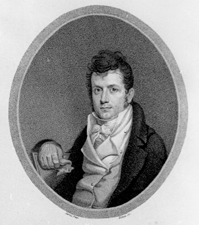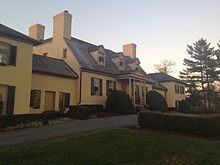Alexander C. Hanson
Alexander Contee Hanson | |
|---|---|
 | |
| United States Senator from Maryland | |
| In office December 20, 1816 – April 23, 1819 | |
| Preceded by | Robert G. Harper |
| Succeeded by | William Pinkney |
| Member of the U.S. House of Representatives from Maryland's 3rd district | |
| In office March 4, 1813 – 1816 | |
| Preceded by | Philip B. Key |
| Succeeded by | George Peter |
| Member of the Maryland House of Delegates | |
| In office 1811–1815 | |
| Personal details | |
| Born | February 27, 1786 Annapolis, Maryland |
| Died | April 23, 1819 (aged 33) Elkridge, Maryland |
| Political party | Federalist |
| Spouse | Priscilla Dorsey |
| Children | Charles Grosvenor Hanson |
| Parent(s) | Alexander Contee Hanson, Sr. Rebecca Howard |
| Relatives | Thomas P. Grosvenor (brother-in-law) |
| Alma mater | St. John's College |
Alexander Contee Hanson (February 27, 1786 – April 23, 1819) was an American lawyer, publisher, and statesman. He represented the third district of Maryland in the U.S. House, and the state of Maryland in the U.S. Senate.
Early life
Alexander Contee Hanson was born in Annapolis, Maryland, on February 27, 1786, the second son of Alexander Contee Hanson, Sr. (1749-1806) and Rebecca Howard (ca. 1760-1806). His older brother, Charles W. Hanson, later became a judge in Baltimore.[1] His younger sister, Mary Jane Hanson (1791–1815), was married to Thomas Peabody Grosvenor (1778–1817), a U.S. Representative from New York.[2] He attended local private schools and graduated from St. John's College in Annapolis in 1802.[3]
Family
He was the grandson of John Hanson (1721–1783), a delegate to the Continental Congress who signed the Articles of Confederation and served as the 9th President of the Continental Congress, and Jane Contee (1726–1812), herself the granddaughter of Thomas Brooke, Jr. (1660–1730). Through his paternal grandmother's brother, Thomas Contee (1729-1793), he was related to Benjamin Contee (1755–1815) and Thomas Contee Worthington (1782–1847), William Grafton Delaney Worthington (1785–1856), and Walter Brooke Cox Worthington (1795–1845). His cousin, Rebecca Thomas (1777-1814), was married to another cousin, Alexander Contee Magruder (c. 1779-1853).[4]
Career
He proceeded to study law, was admitted to the bar, and commenced practice in Annapolis. He served as a member of the Maryland House of Delegates from 1811 to 1815.[3]
Federal Republican
Hanson launched the Federal Republican and Commercial Gazette in Baltimore in 1808 and merged it with another publication the following year. The Federal Republican was known as one of the nation’s most extreme Federalist newspapers.[5] On June 22, 1812, four days after the beginning of the War of 1812, a mob that was irritated by his articles denouncing the administration destroyed his office. On July 28, he reissued the paper from another building, where he was joined by a group of armed allies. When that building was besieged by a mob, Hanson and his group fired, killing two. On the morning of July 29, Hanson and his group surrendered to Mayor Edward Johnson, who had come to personally defuse the situation,[6] and were escorted to jail. That evening, the mob stormed the jail, and Hanson was beaten and left for dead. James M. Lingan, a military officer who came to Hanson's defense, died as a result of the violence.[7] Hanson also received help from Revolutionary War Hero and father of Robert E. Lee, Henry Lee III, who received grave injuries. Another man John Thompson recounts being tarred and feathered by the mob and stated that the rioters brought a field gun to besiege Hanson's house, although the arrival of the mayor and other city officials stopped it from being fired.[8] Hanson moved the paper to Georgetown, D.C., where he published it unmolested. Hanson later moved to Elkridge, Maryland.
United States Congress
In 1812, Hanson was elected as a Federalist representing the third district to the Thirteenth and Fourteenth Congresses, serving from March 4, 1813, until his resignation in 1816.[9] Hanson was elected a member of the American Antiquarian Society in 1815.[10] He was an unsuccessful candidate in 1816 for election to the Maryland House of Delegates, but was elected as a Federalist to the United States Senate to fill the vacancy caused by the resignation of Robert Goodloe Harper.[11] He served as senator from December 20, 1816, until his own death on his estate, "Belmont", near Elkridge, Maryland.[12]
Personal life

On June 25, 1805, he was married to Priscilla Dorsey.[13] They had many children, but only one lived to have heirs:[14]
- Charles Grosvenor Hanson (1815/6–1880), who married Annie Maria Worthington (1821–1873), daughter of John Tolley Hood Worthington (1788-1849), on April 16, 1840.[15]
He was interred in the family burial ground at his estate, Belmont.[2]
Descendants
His grandchildren included Alexander Contee Hanson (1840–1857), Mary Worthington Hanson (1842–1863), John Worthington Hanson (1844–1916), Priscilla Hanson (1846–1925), Charles Edward Hanson (b. 1848), Murray Hanson (b. 1851), Samuel Contee Hanson (1854–1889), Grosvenor Hanson (1856–1916), Annie Maria "Nannie" Hanson (1858–1943), and Florence Contee Hanson (1860–1935).[15]
See also
References
- ^ Cutler, Josh S. (Feb 18, 2019). Mobtown Massacre: Alexander Hanson and the Baltimore Newspaper War of 1812. History Press. p. 188. ISBN 1467142271.
- ^ a b Grosvenor, Thomas Peabody (1817). A sketch of the life, last sickness, and death of Mrs. Mary Jane Grosvenor (2nd ed.). Baltimore: Edward J. Coale and Maxwell. Retrieved 16 February 2017.
- ^ a b Eisenberg, Gerson G. Marylanders Who Served the Nation: A Biographical Dictionary of Federal Officials from Maryland. Annapolis: The Maryland State Archives, 1992.
- ^ Archives of Maryland page for Alexander Contee Magruder.
- ^ Cutler, Josh S. (2018). "When the Press Really Was Under Attack: Alexander Hanson and the 1812 'Mobtown' Massacre". New England Journal of History. 75 (Spring).
- ^ Cassell, F. A. (1975). The Great Baltimore Riot of 1812. Maryland Historical Society, 70(3). doi:msa_sc_5881_1_279
- ^ Peters, James Edward (2000). Arlington National Cemetery, Shrine to America's Heroes. Woodbine House. ISBN 1-890627-14-3.
- ^ Scharf, J. Thomas (1874). The chronicles of Baltimore : being a complete history of "Baltimore town" and Baltimore city from the earliest period to the present time. Tuenbull Brothers. pp. 315–337. Retrieved 30 October 2018.
- ^ Marine, William M. The British Invasion of Maryland 1812-1815. Baltimore: Society of the War of 1812 in Maryland, 1913. Excerpts, pp. 7-10.
- ^ American Antiquarian Society Members Directory
- ^ Scharf, J. Thomas. Chronicles of Baltimore. Baltimore: Turnbull Brothers, 1874. Excerpts, pp. 312-338.
- ^ McClarey, Donald R.; Zummo, Paul (16 July 2012). "Alexander Contee Hanson, Jr". Almost Chosen People. Retrieved 16 February 2017.
- ^ "Alexander Contee Hanson, MSA SC 3520-2206". msa.maryland.gov. Maryland State Archives. August 28, 2012. Retrieved 16 February 2017.
- ^ Hammond, John Martin (1914). Colonial mansions of Maryland and Delaware. Philadelphia | London: J.B. Lippincott company. pp. 168–183. Retrieved 16 February 2017.
- ^ a b Hanson, George A. (June 1, 2009). Old Kent: The Eastern Shore of Maryland. Genealogical Publishing Com. ISBN 9780806346328. Retrieved 16 February 2017.
External links
- United States Congress. "Alexander C. Hanson (id: H000176)". Biographical Directory of the United States Congress.
- Paul A. Gilje, "The Baltimore Riots of 1812 and the Breakdown of the Anglo-American Mob Tradition," Journal of Social History 13 (Summer 1980): 547-564.
- PBS Documentary on The War of 1812
Baltimore Riot of 1812
- 1786 births
- 1819 deaths
- Members of the United States House of Representatives from Maryland
- United States senators from Maryland
- Members of the Maryland House of Delegates
- 19th-century American newspaper editors
- St. John's College (Annapolis/Santa Fe) alumni
- Politicians from Annapolis, Maryland
- Maryland Federalists
- Federalist Party United States senators
- American people of English descent
- Federalist Party members of the United States House of Representatives
- People from Elkridge, Maryland
- Members of the American Antiquarian Society
- 19th-century American politicians
- Aides-de-camp of George Washington

